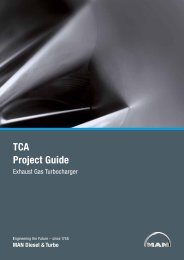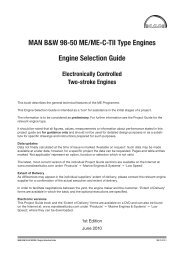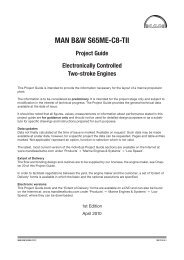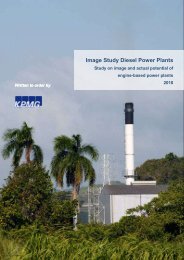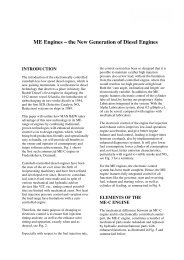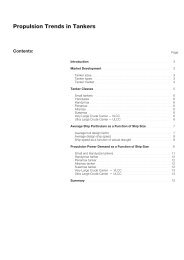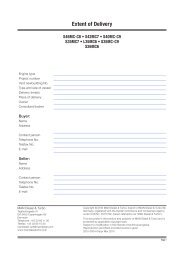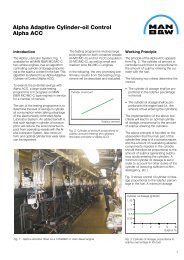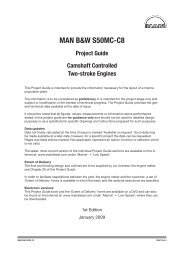- Page 1 and 2: MAN B&W S65ME-C8 Project Guide Elec
- Page 3: MAN B&W Engine Design .............
- Page 6 and 7: MAN B&W Contents MAN B&W S65ME-C8 C
- Page 8 and 9: MAN B&W Contents MAN B&W S65ME-C8 C
- Page 11 and 12: MAN B&W Index A C D MAN B&W S65ME-C
- Page 13 and 14: MAN B&W Index H I L MAN B&W S65ME-C
- Page 15: MAN B&W MAN Diesel Engine Design 1
- Page 18 and 19: MAN B&W 1.01 • Control system wit
- Page 20 and 21: MAN B&W 1.03 Power and Speed with F
- Page 22 and 23: MAN B&W Diesel A/S 1.04 Compar<stro
- Page 24 and 25: MAN B&W 1.06 ME Engine Description
- Page 26 and 27: MAN B&W 1.06 Connecting Rod The con
- Page 28 and 29: MAN B&W 1.06 Exhaust Valve The exha
- Page 31: MAN B&W Engine Layout and Load Diag
- Page 34 and 35: MAN B&W 2.01 placed on the light ru
- Page 39 and 40: MAN B&W 2.04 Engine Layout and Load
- Page 41 and 42: MAN B&W 2.04 Line 6: Propeller curv
- Page 43 and 44: MAN B&W 2.04 ��� ���
- Page 45 and 46: MAN B&W 2.04 Page 7 of Example 2: S
- Page 47 and 48: MAN B&W 2.04 Page 9 of Example 4: S
- Page 49: MAN B&W 2.04 Example 6: Engines run
- Page 52 and 53: MAN B&W 2.06 Specific Fuel Oil Cons
- Page 54 and 55: MAN B&W 2.08 SFOC reference conditi
- Page 56 and 57: MAN B&W Diesel A/S 2.09 SFOC Calcul
- Page 58 and 59: MAN B&W Diesel A/S 2.10 SFOC calcul
- Page 60 and 61: MAN B&W 2.11 Fuel Consumption at an
- Page 63: MAN B&W MAN Diesel Turbocharger Cho
- Page 66 and 67: MAN B&W 3.02 Exhaust Gas By�pass
- Page 68 and 69: MAN B&W 3.03 NO x Reduction by SCR
- Page 71: MAN B&W MAN Diesel Electricity Prod
- Page 74 and 75: MAN B&W 4.01 MAN Diesel Page 2 of 6
- Page 76 and 77: MAN B&W 4.01 PTO/RCF Side mounted g
- Page 78 and 79: MAN B&W 4.01 Yard deliveries are: 1
- Page 80 and 81: MAN B&W 4.03 Engine preparations fo
- Page 82 and 83: MAN B&W 4.03 Crankshaft gear lubric
- Page 84 and 85: MAN B&W 4.03 Air cooler Pole wheel
- Page 86 and 87:
MAN B&W 4.04 PTO type: BW II/GCR Po
- Page 88 and 89:
MAN B&W 4.04 Auxiliary Propulsion S
- Page 90 and 91:
MAN Diesel 4.06 L16/24 GenSet Data
- Page 92 and 93:
MAN Diesel 4.06 L16/24 GenSet Data
- Page 94 and 95:
MAN Diesel 4.07 L21/31 GenSet Data
- Page 96 and 97:
MAN Diesel 4.08 L23/30H GenSet Data
- Page 98 and 99:
MAN Diesel 4.08 L23/30H GenSet Data
- Page 100 and 101:
MAN Diesel 4.09 L27/38 GenSet Data
- Page 102 and 103:
MAN Diesel 4.10 L28/32H GenSet Data
- Page 105:
MAN B&W MAN Diesel Installation Asp
- Page 108 and 109:
MAN B&W 5.02 Space Requirements <st
- Page 110 and 111:
MAN B&W 5.03 Crane beam for turboch
- Page 112 and 113:
MAN B&W Diesel A/S 5.04 Engine room
- Page 114 and 115:
MAN B&W 5.04 MAN B&W Double�Jib C
- Page 116 and 117:
MAN B&W Diesel A/S 5.06 Engine and
- Page 118 and 119:
MAN B&W Diesel A/S 5.06 S65ME-C 3,5
- Page 120 and 121:
MAN B&W Diesel A/S 5.08 Mass of Wat
- Page 122 and 123:
MAN B&W Diesel A/S 5.09 6,244 (AD)
- Page 124 and 125:
MAN B&W 5.10 Counterflanges Referen
- Page 126 and 127:
MAN B&W 5.11 Engine Seating and Hol
- Page 128 and 129:
MAN B&W 5.12 Engine Seating Profile
- Page 130 and 131:
MAN B&W 5.13 Engine Top Bracing The
- Page 132 and 133:
MAN B&W 5.14 Mechanical Top Bracing
- Page 134 and 135:
MAN B&W 5.16 Components for Engine
- Page 136 and 137:
MAN B&W 5.16 EICU (Engine Interface
- Page 138 and 139:
MAN B&W 5.17 Shaftline Earthing Dev
- Page 140 and 141:
MAN B&W 5.17 Suppliers ����
- Page 143 and 144:
MAN B&W 6.01 Calculation of L<stron
- Page 145 and 146:
MAN B&W Diesel A/S 6.03 Page 1 of 5
- Page 147 and 148:
MAN B&W Diesel A/S 6.03 Pumps Coole
- Page 149 and 150:
MAN B&W Diesel A/S 6.03 Capacities
- Page 151 and 152:
MAN B&W Diesel A/S 6.04 The derated
- Page 153 and 154:
MAN B&W Diesel A/S 6.04 Page 4 of 1
- Page 155 and 156:
MAN B&W 6.04 �������
- Page 157 and 158:
MAN B&W 6.04 Exhaust Gas Amount and
- Page 159 and 160:
MAN B&W 6.04 Page 10 of 12 ∆M amb
- Page 161:
MAN B&W Diesel A/S 6.04 Final calcu
- Page 165 and 166:
MAN B&W 7.01 Pressuris</str
- Page 167 and 168:
MAN B&W 7.01 The HCU has a leakage
- Page 169 and 170:
MAN B&W 7.03 Fuel Oil Pipes and Dra
- Page 171 and 172:
MAN B&W 7.04 Heat Loss in Piping Pi
- Page 173 and 174:
MAN B&W 7.05 Components for fuel oi
- Page 175 and 176:
MAN B&W Diesel A/S 7.05 Fuel oil fi
- Page 177:
MAN B&W 7.06 ������ �
- Page 181 and 182:
MAN B&W 8.01 Lubricating and Coolin
- Page 183 and 184:
MAN B&W 8.02 Hydraulic power supply
- Page 185 and 186:
MAN B&W 8.03 From system oil Fig. 8
- Page 187 and 188:
MAN B&W 8.05 Components for Lubrica
- Page 189 and 190:
MAN B&W 8.05 Lubricating oil outlet
- Page 191 and 192:
MAN B&W 8.06 Note: When calculating
- Page 193 and 194:
MAN B&W 8.08 Hydraulic oil back�f
- Page 195 and 196:
MAN B&W 8.09 Hydraulic control oil
- Page 197:
MAN B&W 8.09 Hydraulic Control Oil
- Page 201 and 202:
MAN B&W 9.01 Cylinder Lubricating O
- Page 203 and 204:
MAN B&W 9.02 Due to the sulphur dep
- Page 205 and 206:
MAN B&W 9.02 �������
- Page 207:
MAN B&W 9.02 �������
- Page 211:
MAN B&W 10.01 Stuffing Box Drain Oi
- Page 215 and 216:
MAN B&W 11.01 Central Cooling Water
- Page 217 and 218:
MAN B&W 11.03 Components for Centra
- Page 219:
MAN B&W MAN Diesel Seawater Cooling
- Page 222 and 223:
MAN B&W 12.02 Seawater Cooling Syst
- Page 224 and 225:
MAN B&W 12.04 Components for Seawat
- Page 226 and 227:
MAN B&W 12.06 Jacket Cooling Water
- Page 228 and 229:
MAN B&W 12.07 Deaerating tank �
- Page 231:
MAN B&W MAN Diesel Starting and Con
- Page 234 and 235:
MAN B&W 13.02 Components for Starti
- Page 236 and 237:
MAN B&W 13.03 Exhaust Valve Air Spr
- Page 239:
MAN B&W MAN Diesel Scavenge Air 14
- Page 242 and 243:
MAN B&W 14.02 Auxiliary Blowers The
- Page 244 and 245:
MAN B&W 14.04 Electric Motor for Au
- Page 246 and 247:
MAN B&W 14.06 Scavenge Air Box Drai
- Page 248 and 249:
MAN B&W 14.07 ������ Th
- Page 251 and 252:
MAN B&W 15.01 Exhaust Gas System Th
- Page 253 and 254:
MAN B&W 15.02 Cleaning Systems �
- Page 255 and 256:
MAN B&W 15.03 Exhaust Gas System fo
- Page 257 and 258:
MAN B&W 15.04 Exhaust gas silencer
- Page 259 and 260:
MAN B&W 15.05 Measuring Back Pressu
- Page 261 and 262:
MAN B&W 15.06 Forces and Moments at
- Page 263:
MAN B&W 15.07 Diameter of Exhaust G
- Page 267 and 268:
MAN B&W 16.01 Engine Control System
- Page 269 and 270:
MAN B&W 16.01 Engine Control System
- Page 271 and 272:
MAN B&W 16.01 Mechanical�hydrauli
- Page 273 and 274:
MAN B&W 16.01 Auxiliary equipment s
- Page 275:
MAN B&W MAN Diesel Vibration Aspect
- Page 278 and 279:
MAN B&W 17.02 2nd Order Moments on
- Page 280 and 281:
MAN B&W 17.03 Electric Driven Momen
- Page 282 and 283:
MAN B&W Power Related Unbalance <st
- Page 284 and 285:
MAN B&W 17.05 �������
- Page 286 and 287:
MAN B&W 17.06 Axial Vibrations When
- Page 288 and 289:
MAN B&W Diesel A/S 17.07 External F
- Page 291 and 292:
MAN B&W 18.01 Monitoring Systems an
- Page 293 and 294:
MAN B&W 18.02 PMI System, Type On
- Page 295 and 296:
MAN B&W 18.03 CoCoS�EDS Sensor L<
- Page 297 and 298:
MAN B&W 18.04 General outline of th
- Page 299 and 300:
MAN B&W 18.04 Alarms for UMS - Clas
- Page 301 and 302:
MAN B&W 18.04 Slow down for UMS - C
- Page 303 and 304:
MAN B&W 18.05 Local Instruments Pag
- Page 305 and 306:
MAN B&W 18.05 Local instruments Rem
- Page 307 and 308:
MAN B&W 18.06 Fig. 18.06.01a: Oil m
- Page 309 and 310:
MAN B&W 18.06 Bearing Temperature M
- Page 311:
MAN B&W 18.07 Identification of Ins
- Page 315 and 316:
MAN B&W 19.01 Disp
- Page 317 and 318:
MAN B&W 19.02 Specification for pai
- Page 319 and 320:
MAN B&W 19.03 A3 + B3 (option 4 12
- Page 321 and 322:
MAN B&W Dispatch P
- Page 323 and 324:
MAN B&W 19.06 List
- Page 325 and 326:
MAN B&W 19.07 Exhaust valve, <stron
- Page 327 and 328:
MAN B&W 19.08 Table B: Page 2 of 2
- Page 329 and 330:
MAN B&W Diesel A/S 19.10 Li
- Page 331:
MAN B&W MAN Diesel Project Suppport
- Page 334 and 335:
MAN B&W 20.02 Computeris</s
- Page 336 and 337:
MAN B&W 20.03 We base our first quo
- Page 338 and 339:
MAN B&W 20.04 Main Section 939 Engi
- Page 340 and 341:
MAN B&W 20.04 Engine production and
- Page 343 and 344:
MAN B&W Appendix A Symbols for Pipi
- Page 345:
MAN B&W Appendix A No. Symbol Symbo



